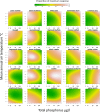Disentangling the effects of a century of eutrophication and climate warming on freshwater lake fish assemblages
- PMID: 28777816
- PMCID: PMC5544199
- DOI: 10.1371/journal.pone.0182667
Disentangling the effects of a century of eutrophication and climate warming on freshwater lake fish assemblages
Abstract
Eutrophication and climate warming are profoundly affecting fish in many freshwater lakes. Understanding the specific effects of these stressors is critical for development of effective adaptation and remediation strategies for conserving fish populations in a changing environment. Ecological niche models that incorporated the individual effects of nutrient concentration and climate were developed for 25 species of fish sampled in standard gillnet surveys from 1,577 Minnesota lakes. Lake phosphorus concentrations and climates were hindcasted to a pre-disturbance period of 1896-1925 using existing land use models and historical temperature data. Then historical fish assemblages were reconstructed using the ecological niche models. Substantial changes were noted when reconstructed fish assemblages were compared to those from the contemporary period (1981-2010). Disentangling the sometimes opposing, sometimes compounding, effects of eutrophication and climate warming was critical for understanding changes in fish assemblages. Reconstructed abundances of eutrophication-tolerant, warmwater taxa increased in prairie lakes that experienced significant eutrophication and climate warming. Eutrophication-intolerant, warmwater taxa abundance increased in forest lakes where primarily climate warming was the stressor. Coolwater fish declined in abundance in both ecoregions. Large changes in modeled abundance occurred when the effects of both climate and eutrophication operated in the same direction for some species. Conversely, the effects of climate warming and eutrophication operated in opposing directions for other species and dampened net changes in abundance. Quantifying the specific effects of climate and eutrophication will allow water resource managers to better understand how lakes have changed and provide expectations for sustainable fish assemblages in the future.
Conflict of interest statement
Figures




Similar articles
-
Fish-mediated plankton responses to increased temperature in subtropical aquatic mesocosm ecosystems: Implications for lake management.Water Res. 2018 Nov 1;144:304-311. doi: 10.1016/j.watres.2018.07.055. Epub 2018 Jul 23. Water Res. 2018. PMID: 30071399
-
Climate warming reduces fish production and benthic habitat in Lake Tanganyika, one of the most biodiverse freshwater ecosystems.Proc Natl Acad Sci U S A. 2016 Aug 23;113(34):9563-8. doi: 10.1073/pnas.1603237113. Epub 2016 Aug 8. Proc Natl Acad Sci U S A. 2016. PMID: 27503877 Free PMC article.
-
Warming-driven shifts in ecological control of fish communities in a large northern Chinese lake over 66 years.Sci Total Environ. 2021 May 20;770:144722. doi: 10.1016/j.scitotenv.2020.144722. Epub 2021 Jan 22. Sci Total Environ. 2021. PMID: 33736366
-
The influence of changing climate on the ecology and management of selected Laurentian Great Lakes fisheries.J Fish Biol. 2010 Nov;77(8):1764-82. doi: 10.1111/j.1095-8649.2010.02759.x. Epub 2010 Oct 11. J Fish Biol. 2010. PMID: 21078089 Review.
-
Long-term oceanographic and ecological research in the Western English Channel.Adv Mar Biol. 2005;47:1-105. doi: 10.1016/S0065-2881(04)47001-1. Adv Mar Biol. 2005. PMID: 15596166 Review.
Cited by
-
Getting off the ladder: Disentangling water quality indices to enhance the valuation of divergent ecosystem services.Proc Natl Acad Sci U S A. 2023 May 2;120(18):e2120261120. doi: 10.1073/pnas.2120261120. Epub 2023 Apr 24. Proc Natl Acad Sci U S A. 2023. PMID: 37094116 Free PMC article.
-
Human pressures modulate climate-warming-induced changes in size spectra of stream fish communities.Nat Ecol Evol. 2023 Jul;7(7):1072-1078. doi: 10.1038/s41559-023-02083-z. Epub 2023 Jun 1. Nat Ecol Evol. 2023. PMID: 37264200
-
Valuing improvements in the ecological integrity of local and regional waters using the biological condition gradient.Proc Natl Acad Sci U S A. 2023 May 2;120(18):e2120251119. doi: 10.1073/pnas.2120251119. Epub 2023 Apr 24. Proc Natl Acad Sci U S A. 2023. PMID: 37094119 Free PMC article.
References
-
- Schindler DW. The cumulative effects of climate warming and other human stresses on Canadian freshwaters in the new millennium. Can J Fish Aquat Sci. 2001;58: 18–29. doi: 10.1139/cjfas-58-1-18 - DOI
-
- Dudgeon D, Arthington AH, Gessner MO, Kawabata Z-I, Knowler DJ, Lévêque C, et al. Freshwater biodiversity: importance, threats, status and conservation challenges. Biol Rev. 2006;81: 163 doi: 10.1017/S1464793105006950 - DOI - PubMed
-
- Jeppesen E, Meerhoff M, Holmgren K, González-Bergonzoni I, Teixeira-de Mello F, Declerck SAJ, et al. Impacts of climate warming on lake fish community structure and potential effects on ecosystem function. Hydrobiologia. 2010;646: 73–90. doi: 10.1007/s10750-010-0171-5 - DOI
-
- Shimoda Y, Azim ME, Perhar G, Ramin M, Kenney MA, Sadraddini S, et al. Our current understanding of lake ecosystem response to climate change: What have we really learned from the north temperate deep lakes? J Gt Lakes Res. 2011;37: 173–193. doi: 10.1016/j.jglr.2010.10.004 - DOI
-
- Jeppesen E, Mehner T, Winfield IJ, Kangur K, Sarvala J, Gerdeaux D, et al. Impacts of climate warming on the long-term dynamics of key fish species in 24 European lakes. Hydrobiologia. 2012;694: 1–39. doi: 10.1007/s10750-012-1182-1 - DOI
MeSH terms
LinkOut - more resources
Full Text Sources
Other Literature Sources
Medical

